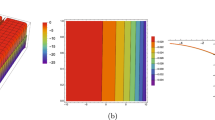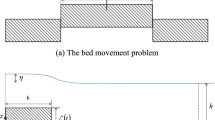Abstract
A two-dimensional (0xz) numerical model that makes it possible to calculate the initial elevation of the water surface in the source of a tsunami in a basin of variable depth is developed in the potential theory of an incompressible fluid under the approximation of an instantaneous deformation of the sea bottom. The model makes it possible to take into account the contribution of the horizontal component of the bottom deformation and the smoothing effect of the water layer through the use of the σ coordinate. To test the numerical model, we obtained an analytical solution to the problem of the initial elevation in a basin with a flat sloping bottom with a bottom deformation of a triangular shape. The results of the test show that for a spatial step typical for numerical tsunami models, there is close agreement between the numerical and analytical solutions. Using the developed σ model, we calculate the initial elevations of the water surface during the Kuril earthquake on January 13, 2007 and the Great East Japan Tohoku earthquake on March 11, 2011 (along the selected 2D sections). The results obtained are used to test an approximate method for calculating the initial elevation, known as the Kajiura filter, in which the ocean depth is assumed to be constant throughout the area of the source of the tsunami.



Similar content being viewed by others
REFERENCES
M. A. Nosov, “Tsunami waves of seismic origin: The modern state of knowledge,” Izv. Atmos. Ocean. Phys. 50 (5), 474–484 (2014). https://doi.org/10.1134/S0001433814030098
A. R. Gusman, I. E. Mulia, K. Satake, S. Watada, M. Heidarzadeh, and A. F. Sheehan, “Estimate of tsunami source using optimized unit sources and including dispersion effects during tsunami propagation: The 2012 Haida Gwaii earthquake,” Geophys. Res. Lett. 43 (18), 9819–9828 (2016). https://doi.org/10.1002/2016GL070140
G. C. Lotto, G. Nava, and E. M. Dunham, “Should tsunami simulations include a nonzero initial horizontal velocity?,” Earth, Planets Space 69 (1), 117, 1–14 (2017). https://doi.org/10.1186/s40623-017-0701-8
T. Maeda and T. Furumura, “FDM simulation of seismic waves, ocean acoustic waves, and tsunamis based on tsunami-coupled equations of motion,” Pure Appl. Geophys. 170 (1), 109–127 (2013). https://doi.org/10.1007/s00024-011-0430-z
J. E. Kozdon and E. M. Dunham, “Constraining shallow slip and tsunami excitation in megathrust ruptures using seismic and ocean acoustic waves recorded on ocean-bottom sensor networks,” Earth Planet. Sci. Lett. 396, 56–65 (2014). https://doi.org/10.1016/j.epsl.2014.04.001
G. C. Lotto, T. N. Jeppson, and E. M. Dunham, “Fully coupled simulations of megathrust earthquakes and tsunamis in the Japan Trench, Nankai Trough, and Cascadia Subduction Zone,” Pure Appl. Geophys. 176, 4009–4041 (2019). https://doi.org/10.1007/s00024-018-1990-y
S. Popinet, “Adaptive modelling of long-distance wave propagation and fine-scale flooding during the Tohoku tsunami,” Nat. Hazards Earth Syst. Sci. 12 (4), 1213–1227 (2012). https://doi.org/10.5194/nhess-12-1213-2012
S. Iwasaki, “Experimental study of a tsunami generated by a horizontal motion of a sloping bottom,” Bull. Earthquake Res. Inst. 57, 239–262 (1982).
Y. Tanioka and K. Satake, “Tsunami generation by horizontal displacement of ocean bottom,” Geophys. Res. Lett. 23 (8), 861–864 (1996). https://doi.org/10.1029/96GL00736
M. A. Nosov, A. V. Bolshakova, and S. V. Kolesov, “Displaced water volume, potential energy of initial elevation, and tsunami intensity: Analysis of recent tsunami events,” Pure Appl. Geophys. 171 (12). 3515–3525 (2014). https://doi.org/10.1007/s00024-013-0730-6
A. V. Bolshakova, M. A. Nosov, and S. V. Kolesov, “The properties of co-seismic deformations of the ocean bottom as indicated by the slip-distribution data in tsunamigenic earthquake sources,” Moscow Univ. Phys. Bull. 70 (1), 62–67 (2015). https://doi.org/10.3103/S0027134915010038
M. A. Nosov, A. V. Bolshakova, and K. A. Sementsov, “Energy characteristics of tsunami sources and the mechanism of wave generation by seismic movements of the ocean floor,” Moscow Univ. Phys. Bull. 76, S136–S142 (2021). https://doi.org/10.3103/S0027134922010076
R. Takahashi, “On seismic sea waves caused by deformations of the sea bottom,” Bull. Earthquake Res. Inst. 20, 357–400 (1942).
K. Kajiura, “The leading wave of a tsunami,” Bull. Earthquake Res. Inst. 41, 535–571 (1963).
M. A. Nosov and S. V. Kolesov, “Optimal initial conditions for simulation of seismotectonic tsunamis,” Pure Appl. Geophys. 168 (6–7), 1223–1237 (2011). https://doi.org/10.1007/s00024-010-0226-6
M. A. Nosov and K. A. Sementsov, “Calculation of the initial elevation at the tsunami source using analytical solutions,” Izv. Atmos. Ocean. Phys. 50 (5), 539–546 (2014). https://doi.org/10.1134/S0001433814050089
M. A. Nosov, Introduction to Tsunami Wave Theory (Yanus-K, Moscow, 2019) [in Russian].
K. Aki and P. G. Richards, Quantitative Seismology, 2nd ed. (Univ. Sci. Books, Sausalito, CA, 2002).
C. Ji, D. J. Wald, and D. V. Helmberger, “Source description of the 1999 Hector Mine, California, earthquake, Part I: Wavelet domain inversion theory and resolution analysis,” Bull. Seismol. Soc. Am. 92 (4), 1192–1207 (2002). https://doi.org/10.1785/0120000916
S. E. Minson, J. R. Murray, J. O. Langbein, and J. S. Gomberg, “Real-time inversions for finite fault slip models and rupture geometry based on high-rate GPS data,” J. Geophys. Res.: Solid Earth 119, 3201–3231 (2014). https://doi.org/10.1002/2013JB010622
S. Kawamoto, Y. Ohta, Y. Hiyama, M. Todoriki, T. Nishimura, T. Furuya, Y. Sato, T. Yahagi, and K. Miyagawa, “REGARD: A new GNSS-based real-time finite fault modeling system for GEONET,” J. Geophys. Res.: Solid Earth 122, 1324–1349 (2017).
S. Watada, S. Kusumoto, and K. Satake, “Traveltime delay and initial phase reversal of distant tsunamis coupled with the self-gravitating elastic Earth,” J. Geophys. Res.: Solid Earth 119, 4287–4310 (2014).
T.-C. Ho, K. Satake, and S. Watada, “Improved phase corrections for transoceanic tsunami data in spatial and temporal source estimation: Application to the 2011 Tohoku earthquake,” J. Geophys. Res.: Solid Earth 122 (12), 10155–10175 (2017). https://doi.org/10.1002/2017JB015070
J. L. Hammack, “A note on tsunamis: their generation and propagation in an ocean of uniform depth,” J. Fluid Mech. 60 (4), 769–799 (1973). https://doi.org/10.1017/S0022112073000479
S. N. Ward, “Tsunamis,” in The Encyclopedia of Physical Science and Technology, 3rd ed., Ed. by R. A. Meyers (Academic Press, San Diego, 2001), Vol. 17, pp. 175–191.
Y. Kervella, D. Dutykh, and F. Dias, “Comparison between three-dimensional linear and nonlinear tsunami generation models,” Theor. Comput. Fluid Dyn. 21 (4), 245–269 (2007). https://doi.org/10.1007/s00162-007-0047-0
T. Saito and T. Furumura, “Three-dimensional tsunami generation simulation due to sea-bottom deformation and its interpretation based on the linear theory,” Geophys. J. Int. 178 (2), 877–888 (2009). https://doi.org/10.1111/j.1365-246X.2009.04206.x
Y. Tanioka and T. Seno, “Sediment effect on tsunami generation of the 1896 Sanriku tsunami earthquake,” Geophys. Res. Lett. 28 (17), 3389–3392 (2001). https://doi.org/10.1029/2001GL013149
H. Tsushima, R. Hino, Y. Tanioka, F. Imamura, and H. Fujimoto, “Tsunami waveform inversion incorporating permanent seafloor deformation and its application to tsunami forecasting,” J. Geophys. Res. 117, B03311 (2012). https://doi.org/10.1029/2011JB008877
T. Baba, Y. Gon, K. Imai, K. Yamashita, T. Matsuno, M. Hayashi, and H. Ichihara, “Modeling of a dispersive tsunami caused by a submarine landslide based on detailed bathymetry of the continental slope in the Nankai trough, southwest Japan,” Tectonophys. 768, 228182 (2019). https://doi.org/10.1016/j.tecto.2019.228182
T. Saito, “Tsunami generation: validity and limitations of conventional theories,” Geophys. J. Int. 210 (3), 1888–1900 (2017). https://doi.org/10.1093/gji/ggx275
T. Baba, S. Allgeyer, J. Hossen, P. R. Cummins, H. Tsushima, K. Imai, K. Yamashita, and T. Kato, “Accurate numerical simulation of the far-field tsunami caused by the 2011 Tohoku earthquake, including the effects of Boussinesq dispersion, seawater density stratification, elastic loading, and gravitational potential change,” Ocean Modell. 111, 46–54 (2017). https://doi.org/10.1016/j.ocemod.2017.01.002
I. V. Fine and E. A. Kulikov, “Calculation of sea surface displacements in a tsunami source area caused by instantaneous vertical deformation of the seabed due to an underwater earthquake,” Vychisl. Tekhnol. 16 (2), 111–118 (2011).
T. Saito, “Dynamic tsunami generation due to sea-bottom deformation: Analytical representation based on linear potential theory,” Earth, Planets Space 65 (12), 1411–1423 (2013). https://doi.org/10.5047/eps.2013.07.004
E. A. Kulikov, V. K. Gusiakov, A. A. Ivanova, and B. V. Baranov, “Numerical tsunami modelling and the bottom relief,” Moscow Univ. Phys. Bull. 71 (6), 527–536 (2016). https://doi.org/10.3103/S002713491605012X
E. A. Kulikov, A. Yu. Medvedeva, and I. V. Fain, “Tsunami hazard assessment in the Caspian Sea,” Okeanol. Issled. (Oceanol. Res.) 47 (5), 74–88 (2019). https://doi.org/10.29006/1564-2291.JOR-2019.47(5).6
T. Saito, Tsunami Generation and Propagation (Springer, Tokyo, 2019). https://doi.org/10.1007/978-4-431-56850-6
M. A. Nosov and S. V. Kolesov, “Method of specification of the initial conditions for numerical tsunami modeling,” Moscow Univ. Phys. Bull. 64 (2), 208–213 (2009). https://doi.org/10.3103/S0027134909020222
O. M. Phillips, “On the generation of waves by turbulent wind,” J. Fluid Mech. 2 (5), 417–445 (1957). https://doi.org/10.1017/S0022112057000233
Y.-Y. Li, B. Wang, and D.-H. Wang, “Characteristics of a terrain-following sigma coordinate,” Atmos. Ocean. Sci. Lett. 4 (3), 157–161 (2011). https://doi.org/10.1080/16742834.2011.11446922
S. M. Griffies, C. Böning et al., “Developments in ocean climate modelling,” Ocean Modell. 2 (3-4), 123–192 (2000). https://doi.org/10.1016/S1463-5003(00)00014-7
A. V. Gusev, “Numerical model of ocean hydrodynamics in curvilinear coordinates for reproducing the circulation of the world ocean and its separate water areas,” Candidate’s Dissertation in Physics and Mathematics (Inst. Vychisl. Mat., Moscow, 2009).
N. A. Dianskii, Modeling Ocean Circulation and Studying Its Response to Short-Term and Long-Term Atmospheric Impacts (Fizmatlit, Moscow, 2013) [in Russian].
M. A. Nosov and S. V. Kolesov, “Combined numerical model of a tsunami,” Math. Models Comput. Simul. 11 (5), 679–689 (2019). https://doi.org/10.1134/S2070048219050156
K. A. Sementsov, M. A. Nosov, S. V. Kolesov, V. A. Karpov, H. Matsumoto, and Y. Kaneda, “Free gravity waves in the ocean excited by seismic surface waves: Observations and numerical simulations,” J. Geophys. Res. Oceans 124 (11), 8468–8484 (2019). https://doi.org/10.1029/2019JC015115
R. L. Haney, “On the pressure gradient force over steep topography in sigma coordinate ocean models,” J. Phys. Oceanogr. 21 (4), 610–619 (1991). https://doi.org/10.1175/1520-0485(1991)021<0610:OTPGFO>2.0.CO;2
A. Beckmann and D. B. Haidvogel, “Numerical simulation of flow around a tall isolated seamount. Part I: Problem formulation and model accuracy,” J. Phys. Oceanogr. 23 (8), 1736–1753 (1993). https://doi.org/10.1175/1520-0485(1993)023<1736:NSOFAA>2.0.CO;2
K. A. Sementsov and A. V. Bolshakova, “A model for the generation of waves in the ocean by seismic bottom movements in sigma-coordinates,” Moscow Univ. Phys. Bull. 75 (1), 87–94 (2020). https://doi.org/10.3103/S0027134920010129
A. A. Samarskii, Introduction to the Theory of Difference Schemes (Nauka, Moscow, 1971) [in Russian].
K. A. Sementsov, “Dynamic and static models of generation of surface gravity waves in the ocean by earthquakes,” Candidate’s Dissertation in Physics and Mathematics (Mosk. Gos. Univ. im. M. V. Lomonosova, Moscow, 2017).
Y. Okada, “Surface deformation due to shear and tensile faults in a half-space,” Bull. Seismol. Soc. Am. 75 (4), 1135–1154 (1985). https://doi.org/10.1785/BSSA0750041135
B. W. Levin and M. A. Nosov, Physics of Tsunamis, 2nd ed. (Springer, Cham, 2016). https://doi.org/10.1007/978-3-319-24037-4
ACKNOWLEDGMENTS
The authors thank the reviewer for his numerous valuable comments that contributed to a significant improvement of the manuscript.
Funding
This study was supported by the Russian Science Foundation, grant no. 22-27-00415; https://rscf.ru/project/22-27-00415/.
Author information
Authors and Affiliations
Corresponding author
Ethics declarations
The authors declare that they have no conflicts of interest.
Rights and permissions
About this article
Cite this article
Semenstov, K.A., Nosov, M.A. Calculation of the Initial Elevation of the Water Surface at the Source of a Tsunami in a Basin with Arbitrary Bottom Topography. Math Models Comput Simul 15, 746–758 (2023). https://doi.org/10.1134/S2070048223040166
Received:
Revised:
Accepted:
Published:
Issue Date:
DOI: https://doi.org/10.1134/S2070048223040166




